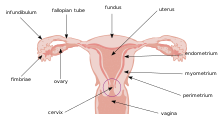Fallopian tube cancer
 From Wikipedia the free encyclopedia
From Wikipedia the free encyclopedia
| Primary fallopian tube cancer | |
|---|---|
 | |
| Specialty | Oncology |
Primary fallopian tube cancer (PFTC), also known as tubal cancer, is a malignant neoplasm that originates from the fallopian tube.[1][2] Along with primary ovarian and peritoneal carcinomas, it is grouped under epithelial ovarian cancers, cancers of the ovary that originate from a fallopian tube precursor.[3][4]
Signs and symptoms[edit]
Initially symptoms may be vague and later may include abnormal vaginal bleeding, blood stained vaginal discharge, abdominal pain, or a large abdomen.[5]
Vaginal discharge in fallopian tube carcinoma results from intermittent hydrosalphinx, also known as hydrops tubae profluens.[6]
Pathology[edit]
The most common cancer type within this disease is adenocarcinoma; in the largest series of 3,051 cases as reported by Stewart et al. 88% of cases fell into this category.[7] According to their study, half of the cases were poorly differentiated, 89% unilateral, and the distribution showed a third each with local disease only, with regional disease only, and with distant extensions. Rarer forms of tubal neoplasm include leiomyosarcoma, and transitional cell carcinoma.
As the tumor is often enmeshed with the adjacent ovary, it may be the pathologist and not the surgeon who determines that the lesion is indeed tubal in origin.
Secondary tubal cancer usually originates from cancer of the ovaries, the endometrium, the GI tract, the peritoneum, and the breast.
Diagnosis[edit]
A pelvic examination may detect an adnexal mass. A CA-125 blood test is a nonspecific test that tends to be elevated in patients with tubal cancer. More specific tests are a gynecologic ultrasound examination, a CT scan, or an MRI of the pelvis. Occasionally, an early fallopian tube cancer may be detected by chance during pelvic surgery.
Staging[edit]
International Federation of Gynecology and Obstetrics (FIGO) staging is done at the time of surgery:
- Stage 0: Carcinoma in situ
- Stage I: Growth limited to fallopian tubes
- Stage II: Growth involving one or both fallopian tubes with extension to pelvis
- Stage III: Tumor involving one or both fallopian tubes with spread outside pelvis
- Stage IV: Growth involving one or more fallopian tubes with distant metastases
Treatment[edit]
The initial approach to tubal cancer is generally surgical, and similar to that of ovarian cancer. As the lesion will spread first to the adjacent uterus and ovary, a total abdominal hysterectomy is an essential part of this approach, removing the ovaries, the tubes, and the uterus with the cervix. Also, peritoneal washings are taken, the omentum is removed, and pelvic and paraaortic lymph nodes are sampled. Staging at the time of surgery and pathological findings will determine further steps. In advanced cases when the cancer has spread to other organs and cannot be completely removed, cytoreductive surgery is used to lessen the tumor burden for subsequent treatments. Surgical treatments are typically followed by adjuvant, usually platinum-based, chemotherapy.[8][9] Radiation therapy has been applied with some success to patients with tubal cancer for palliative or curative indications.[10]
Prognosis[edit]
Prognosis depends to a large degree on the stage of the condition. In 1991 it was reported that about half of the patients with advanced stage disease survived 5 years with a surgical approach followed by cisplatinum-based chemotherapy.[11]
Frequency[edit]
Tubal cancer is thought to be a relatively rare primary cancer among women, accounting for 1 to 2 percent of all gynecologic cancers,[12] In the US, tubal cancer had an incidence of 0.41 per 100,000 women from 1998 to 2003.[7] Demographic distribution is similar to that of ovarian cancer, and the highest incidence is found in white, non-Hispanic women aged 60–79.[7] However, recent evidence suggests tubal cancer to be much more frequent.[2]
Evidence is accumulating that individuals with mutations of BRCA1 and BRCA2 are at higher risk for the development of PFTC.[13][14]
See also[edit]
References[edit]
- ^ WHO Classification of Tumours Editorial Board, ed. (2020). "4. Tumours of the fallopian tube: introduction". Female genital tumours: WHO Classification of Tumours. Vol. 4 (5th ed.). Lyon (France): International Agency for Research on Cancer. p. 216. ISBN 978-92-832-4504-9.
- ^ a b Ferri, Fred F. (2024). "Fallopian tube cancer". Ferri's Clinical Advisor 2024. Philadelphia: Elsevier. p. 568.e5. ISBN 978-0-323-75576-4.
- ^ Stasenko, Marina; Fillipova, Olga; Tew, William P. (July 2019). "Fallopian Tube Carcinoma". Journal of Oncology Practice. 15 (7): 375–382. doi:10.1200/JOP.18.00662. ISSN 1554-7477.
- ^ Rashid, Sameera; Arafah, Maria A.; Akhtar, Mohammed (1 May 2022). "The Many Faces of Serous Neoplasms and Related Lesions of the Female Pelvis: A Review". Advances in Anatomic Pathology. 29 (3): 154–167. doi:10.1097/PAP.0000000000000334. ISSN 1533-4031. PMC 8989637. Archived from the original on 29 July 2022. Retrieved 29 July 2022.
- ^ "Fallopian tube cancer". www.cancerresearchuk.org. Retrieved 30 March 2024.
- ^ GOLDMAN JA, GANS B, ECKERLING B (November 1961). "Hydrops tubae profluens--symptom in tubal carcinoma". Obstet Gynecol. 18: 631–4. PMID 13899814.
- ^ a b c Stewart SL, Wike JM, Foster SL, Michaud F (2007). "The incidence of primary fallopian tube cancer in the United States". Gynecol. Oncol. 107 (3): 392–7. doi:10.1016/j.ygyno.2007.09.018. PMID 17961642.
- ^ Liapis A, Bakalianou K, Mpotsa E, Salakos N, Fotiou S, Kondi-Paffiti A (2008). "Fallopian tube malignancies: A retrospective clinical pathological study of 17 cases". J Obstet Gynaecol. 28 (1): 93–5. doi:10.1080/01443610701811894. PMID 18259909. S2CID 5351886.
- ^ Takeshima N, Hasumi K (2000). "Treatment of fallopian tube cancer. Review of the literature". Arch Gynecol Obstet. 264 (1): 13–9. doi:10.1007/pl00007475. PMID 10985612. S2CID 34114333.
- ^ Schray MF, Podratz KC, Malkasian GD (1987). "Fallopian tube cancer: the role of radiation therapy". Radiother. Oncol. 10 (4): 267–75. doi:10.1016/s0167-8140(87)80032-4. PMID 3444903.
- ^ Barakat RR, Rubin SC, Saigo PE, et al. (1991). "Cisplatin-based combination chemotherapy in carcinoma of the fallopian tube". Gynecol Oncol. 42 (2): 156–160. doi:10.1016/0090-8258(91)90337-5. PMID 1894176.
- ^ UCSF. "Gynecologic Cancer: Fallopian Tube Cancer". accessed 08-14-2008
- ^ BRCA mutations link to tubal cancer, accessed 08-14-2008
- ^ Piek, J. M. J. (2004). Hereditary serous ovarian carcinogenesis, a hypothesis (PhD thesis). Vrije Universiteit Amsterdam. hdl:1871/9013. ISBN 9064646406.